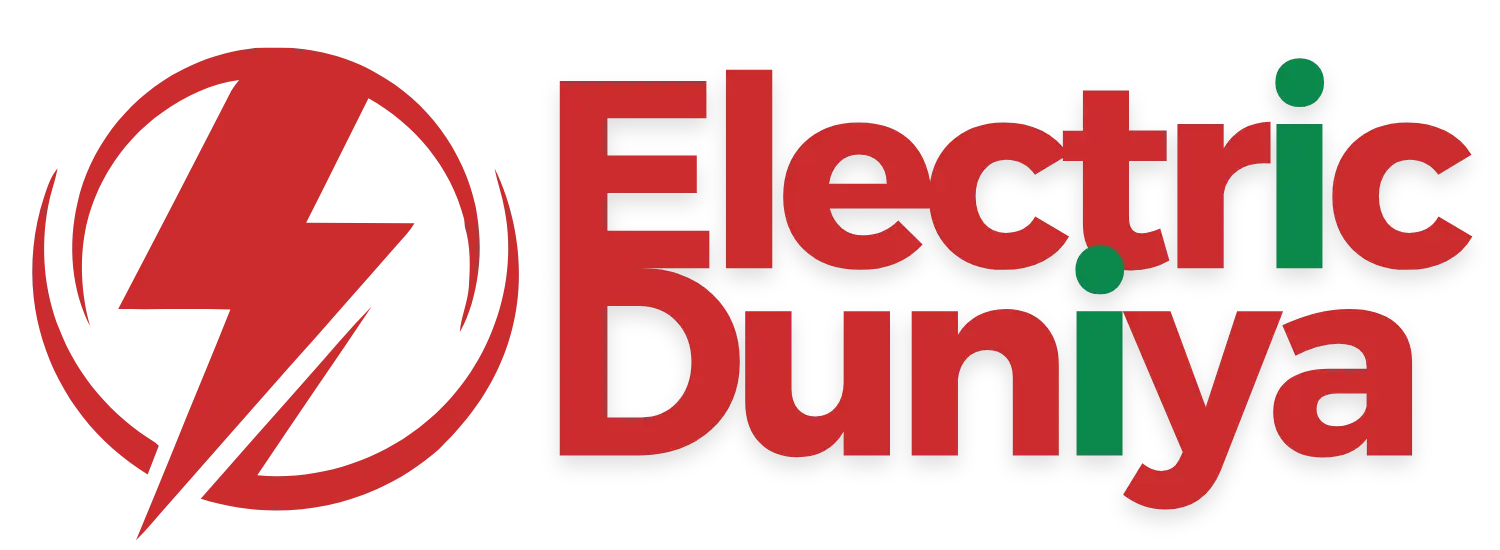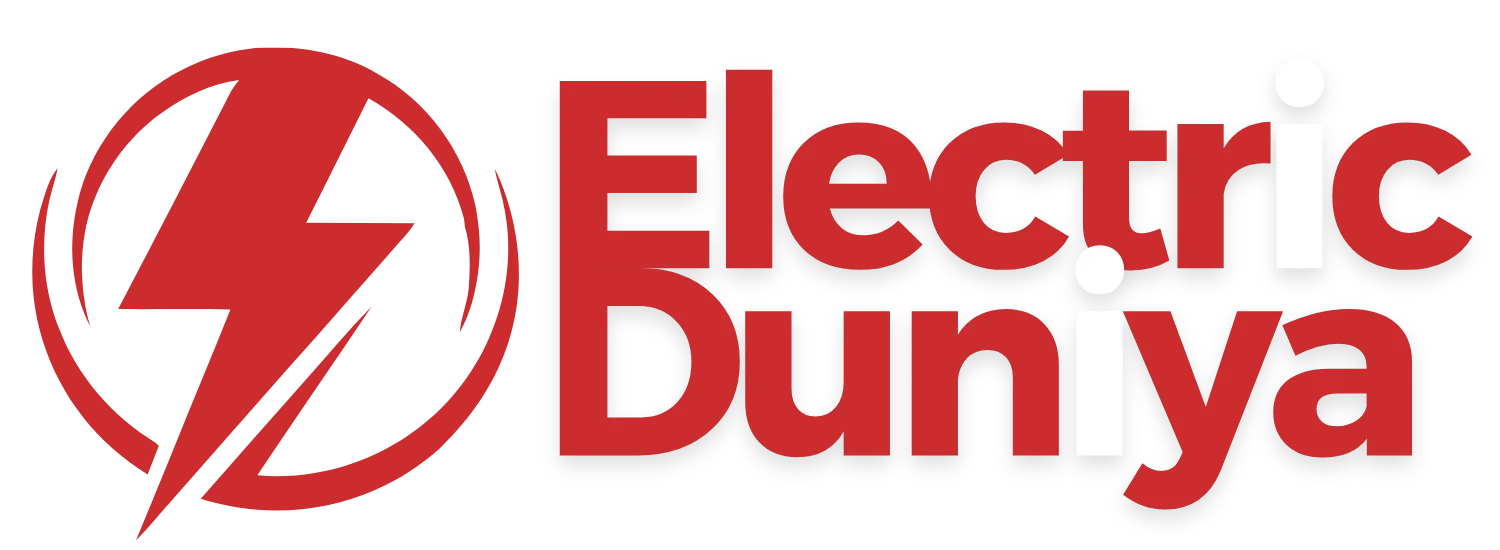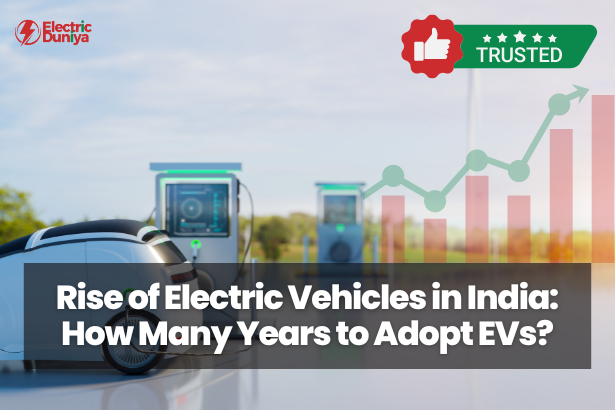As we know, petrol and diesel prices are continuously increasing year after year. This will drive up the demand for electric vehicles (EVs) in India.
The trend of adopting EVs in India has been growing and will continue to do so. People are seeking more affordable solutions for their daily commutes.
Electric vehicles are a better option compared to fuel-powered vehicles. They save money and help keep the environment clean.
In this blog, we’ll explore:
- 1. The number of EVs, including scooters, bikes, and cars, sold in the last four years.
- 2. Which companies are taking advantage of this opportunity.
- 3. Factors that will help grow the trends of electric vehicles in India.
- 4. How many years it will take for EVs to replace fuel-powered vehicles.
So, let’s understand and see what the future holds for electric vehicles in India!
Types of EVs and Sales Data (2020-2023)
I researched various authoritative websites related to electric vehicles and provided accurate data on the rise of electric vehicles (EVs) in India.
I compiled sales figures for electric scooters, bikes, and cars from 2020 to 2023.
1. Electric Scooter
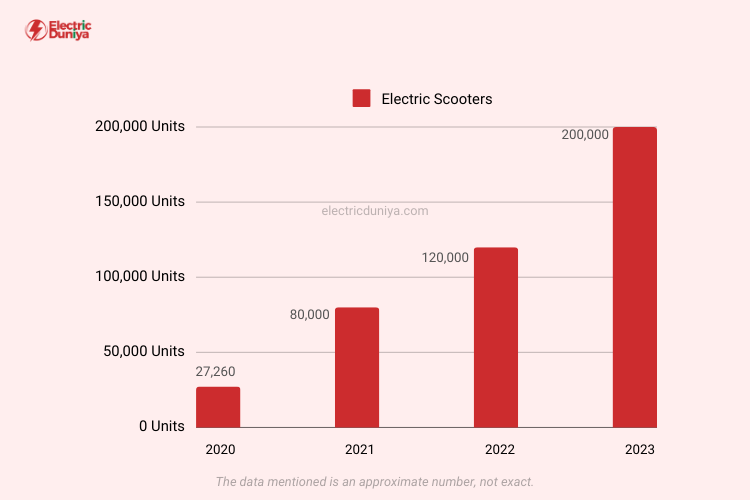
In my analysis, electric scooter sales are truly soaring! From 2020 to 2021, I saw an incredible 193% increase in sales, which was nothing short of outstanding.
The growth didn’t stop there; it continued strongly with a 50% rise from 2021 to 2022, and even more impressive, a 67% jump from 2022 to 2023.
I believe that factors like awareness, rising fuel prices, and advancements in battery technology will drive more consumers toward electric scooters.
That said, I think we might see the growth rate slow down a bit as the market matures. Annual growth percentages will likely settle into a more sustainable range of 20-30%.
Even with this potential slowdown, I’m confident that the electric scooter market will show nice growth in the years ahead.
| Year | Units Sold |
|---|---|
| 2020 | 27,260 |
| 2021 | 80,000 |
| 2022 | 120,000 |
| 2023 | 200,000 |
Electric Scooter Sales by Brands
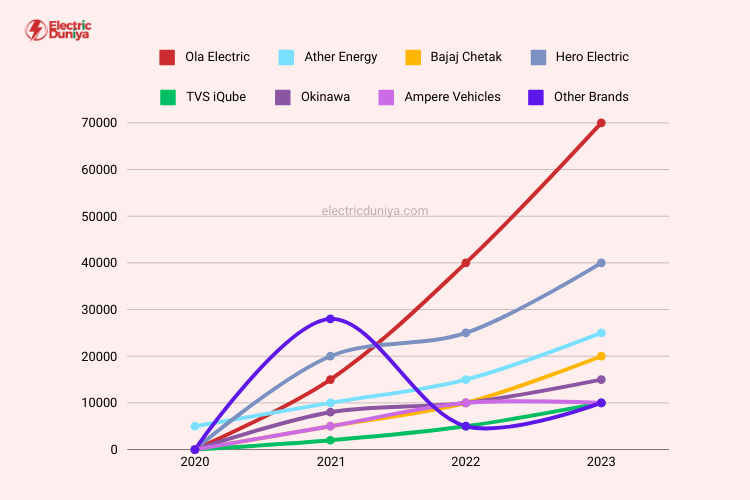
As I gives you sales of brands like Ola Electric, Ather Energy, Bajaj Chetak, and Hero Electric, you’ll get idea of trends that are shaping this rapidly growing industry.
| Brand | 2020 | 2021 | 2022 | 2023 |
|---|---|---|---|---|
| Ola Electric | – | 15,000 | 40,000 | 70,000 |
| Ather Energy | 5,000 | 10,000 | 15,000 | 25,000 |
| Bajaj Chetak | 1,000 | 5,000 | 10,000 | 20,000 |
| Hero Electric | 8,252 | 20,000 | 25,000 | 40,000 |
| TVS iQube | 1,000 | 2,000 | 5,000 | 10,000 |
| Okinawa | 3,000 | 8,000 | 10,000 | 15,000 |
| Ampere Vehicles | 2,000 | 5,000 | 10,000 | 10,000 |
| Other Brands | 2,008 | 28,000 | 5,000 | 10,000 |
2. Electric Bikes
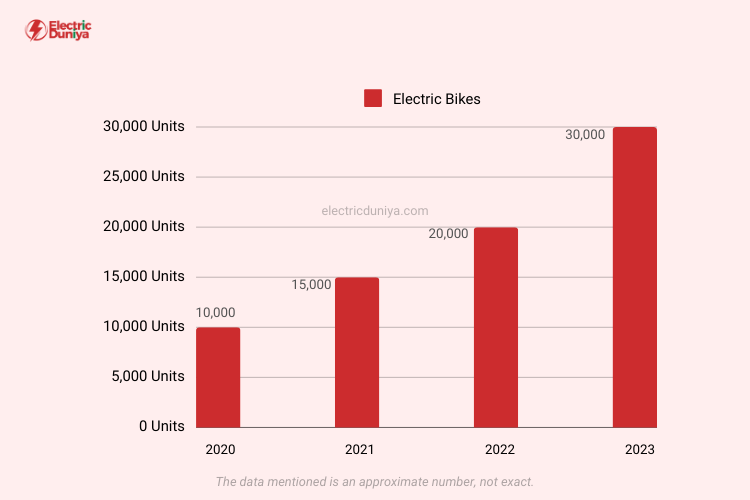
Based on my analysis, electric bike sales are on a steady upward trajectory. From 2020 to 2021, I noticed a solid 50% increase in sales.
This trend continued into the next year with a 33% rise from 2021 to 2022, and then surged again with a 50% jump from 2022 to 2023.
If this trend continues, we can anticipate ongoing expansion in the coming years. I believe that growing interest in eco-friendly transportation, and advancements in e-bike technology will drive this growth.
Although the growth rate has varied between 33% and 50% over recent years, I expect it to stabilize around 40-45% annually in the near future. This would reflect a sustainable growth rate for the maturing e-bike market.
| Year | Units Sold |
|---|---|
| 2020 | 10,000 |
| 2021 | 15,000 |
| 2022 | 20,000 |
| 2023 | 30,000 |
Electric Bike Sales by Brands
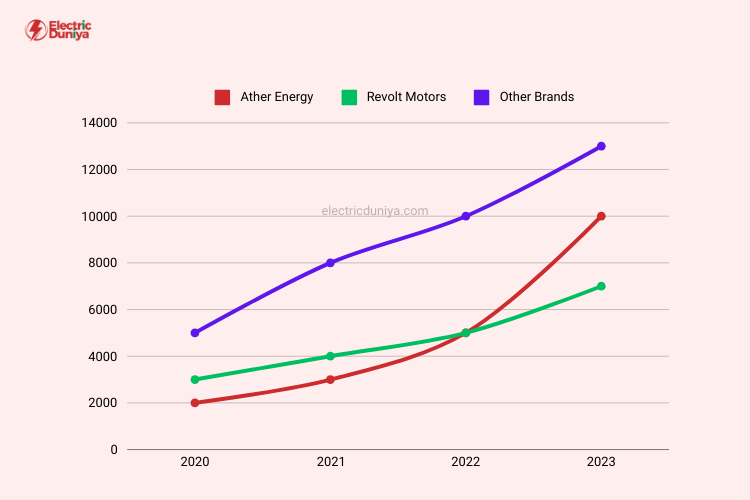
Here are the top electric bike brand’s sales during the last four years, you’ll get infomation about who is doing good in the market.
| Brand | 2020 | 2021 | 2022 | 2023 |
|---|---|---|---|---|
| Ather Energy | 2,000 | 3,000 | 5,000 | 10,000 |
| Revolt Motors | 3,000 | 4,000 | 5,000 | 7,000 |
| Other Brands | 5,000 | 8,000 | 10,000 | 13,000 |
3. Electric Cars
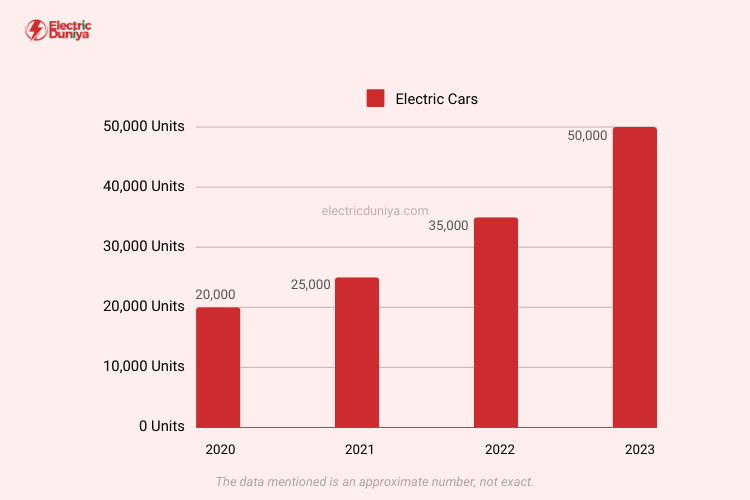
In my analysis, electric car sales are on a clear upward path. From 2020 to 2021, I observed a 25% increase in sales.
The growth rate picked up the following year, with a 40% rise from 2021 to 2022, and it accelerated further with a 43% jump from 2022 to 2023.
This pattern of increasing growth rates suggests a growing consumer interest and adoption of electric cars. If this trend continues, we can expect significant expansion in the coming years.
I believe that improved battery technology, expanding charging infrastructure, and rising awareness will play an important role in growth.
| Year | Units Sold |
|---|---|
| 2020 | 20,000 |
| 2021 | 25,000 |
| 2022 | 35,000 |
| 2023 | 50,000 |
Electric Car Sales by Brands

I will share with you the sales growth of brands like Tata Motors, MG Motors, and Mahindra and the collective performance of other brands in the market.
| Brand | 2020 | 2021 | 2022 | 2023 |
|---|---|---|---|---|
| Tata Motors | 8,000 | 15,000 | 25,000 | 40,000 |
| MG Motors | 2,000 | 5,000 | 7,000 | 8,000 |
| Mahindra | 1,000 | 2,000 | 3,000 | 5,000 |
| Other Brands | 9,000 | 3,000 | 5,000 | 7,000 |
The Future Adoption of EVs in India
After looking at the sales data and consumer behaviour, I’m confident that the electric vehicle (EV) market in India is really taking off. Here’s what I found:
Rising Fuel Prices
The increasing cost of petrol and diesel is a major reason why more people are switching to electric vehicles.
EVs offer a much cheaper way to get around, with lower running costs and savings on fuel and maintenance.
The sales data shows that EV sales in India jumped to 1.3 million units last year, a 50% increase from the previous year.
Clearly, more people are seeing the financial benefits of going electric, especially in cities where commuting costs add up.
Employment Opportunities
I also noticed that more women are joining the workforce and earning between ₹10,000 and ₹20,000 a month.
Many of them are choosing electric scooters because they are affordable and practical for daily use.
The monthly income of men is also growing, especially in urban areas, and due to social status, people are buying cars.
As mentioned earlier, rising petrol prices are forcing them to choose electric vehicles instead of fuel car.
Rising Incomes and Government Support
With incomes going up, especially in smaller cities, more people are ready to invest in electric vehicles.
The Indian government’s goal is to electrify 30% of the vehicle fleet by 2030 and the FAME scheme are making EVs more accessible.
How Many Years Takes to Replace Fuel Vehicles?
Based on my analysis of current trends and projections for the electric vehicle (EV) market in India, I believe that achieving a 50% market share for EVs will likely take about 15 to 20 years.
By 2030, I anticipate that 10% of all vehicle sales in India will be electric.
As technology advances, charging infrastructure expands, and consumer preferences shift, I expect that fuel vehicles will be replaced by EVs very fast.
Based on my research into the sales growth of various EV companies over the last four years and discussions with EV experts, I’ve estimated the percentage of fuel vehicles that will be replaced by EVs over the next 20 to 25 years.
| Year | Percentage of Fuel Vehicles Replaced by EVs (%) | EVs (Millions) |
|---|---|---|
| 2025 | 2% | 0.5 |
| 2030 | 10% | 1.5 |
| 2035 | 20% | 3.0 |
| 2040 | 35% | 7.0 |
| 2045 | 50% | 12.0 |
Final Thoughts
I hope this study of recent sales growth for various types of EVs and their companies helps you understand the future of the electric vehicle market and its growth.
I believe that EVs will be the future. It may take time for people to fully adopt them, but they will definitely grow in the long run.
I’m confident in this because I own both an electric scooter and a car, and I’ve seen how much money I save compared to fuel vehicles. I’m sure that, in time, more people will come to understand and experience the same benefits.
